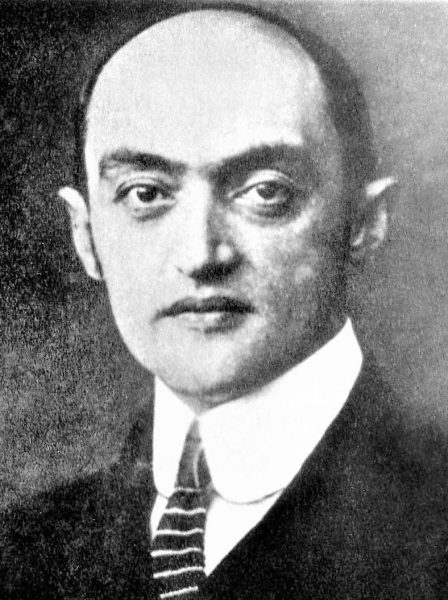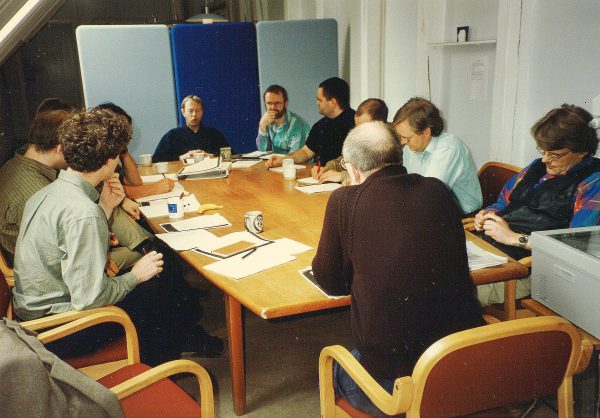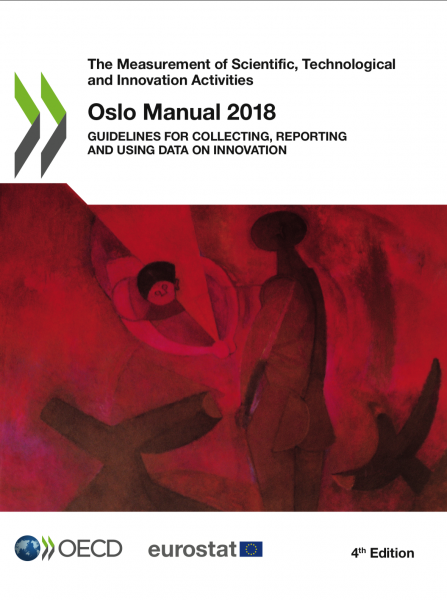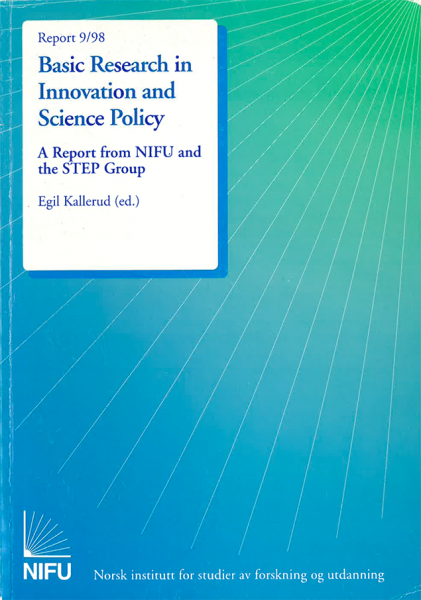In 2004 NIFU merged with STEP, becoming NIFU STEP, an institute that was to cover the whole width of knowledge creation and innovation. While NIFU had had its main foucus on higher education and research, STEP had studied the interaction between companies and institutions in regional, national and international innovation systems.
In this article the first director of STEP, Keith Smith, explains how STEP helped policy makers world wide gain a new understanding of how companies and institutions actually innovate. In this way they also gained a better insight into the interaction between research and society.
By Keith Smith, former director and co-founder of STEP
The STEP Group (Studies in Technology, Innovation and Economic Policy) was a research and policy centre that grew out of the NTNF research program called Future-Oriented Technology Policy (Fremtidsrettet teknologipolitikk, AKA Fremtek). The group lived first as TPOL, one of five research groups in the Norwegian Computing Center (Norsk regnesentral).
In January 1994 STEP was established as an independent centre of research, analysis and policy advice and learning of up to 20 researchers. The Research Council of Norway gave it substantial basic support the first years. After briefly being integrated as a department in SINTEF Teknologiledelse, STEP joined with NIFU in 2004, and has been an integral part of NIFU STEP/NIFU since then.

International Background
STEP was a thoroughly Norwegian group, but it grew out of an international intellectual and research context, with its foundations in the stagnation-inflation crisis of the 1970s.
This was a period of sustained economic crisis, involving the collapse of the international trade and payments system, the OPEC oil price rises, and a great deal of economic turbulence. Politically it led to Reaganism, Thatcherism and a more neoliberal policy turn in many countries, including Norway.
But it also had a big impact on economic thinking – many researchers began to question conventional economics, and often turned to the works of the Austrial economist Joseph Schumpeter as a guide to thinking about events.
Schumpeter argued that the basic way that firms compete is not through lowering prices but by making technological improvements , and that through this growth and economic development are created. Schumpeter clearly saw innovation as a disruptive, unpredictable, dynamic process that did not fit at all into the completely static framework of both mainstream economics and Marxist theory of the period.

These Schumpeterian ideas were reflected in major economic works at that time – Nathan Rosenberg’s great book Perspectives on Technology (1976), and then Richard Nelson’s and Sidney Winter’s An Evolutionary Theory of Economic Change (1982), which both had powerful impacts.
As a concequence, new innovation research groups began to be established in the UK, Denmark, Italy, the Netherlands and Germany, and new researchers emerged in the USA. New journals were established, such as Research Policyin the UK, and this led to a range of new journals over the following decades. In other words, a new field of study was created in the 1980s.
This new field received a major boost in the early 1990s from the OECD. The Science, Technology and Industry Directorate had been established in the early 1960s, but in 1990 a visionary figure, Robert Chabbal, the Deputy Director, organised a rolling series of conferences, workshops, task groups, and publications, called the Technology-Economy Program (TEP). The idea of TEP was to take the emerging field of innovation studies and to push it towards greater prominence and better coordination.
TEP involved hundreds of international researchers, and was the first forum in which they were able to meet and discuss. Several of the early members of STEP took part in the program, and all were strongly influenced by it. TEP gave rise to a number of big books, especially the concluding report called Technology and the Economy: the Key Relationships. This was the first big policy statement of non-linear models of innovation, systems theories, and quantitative growth models.
But TEP also led to a lot of technical work, for example on statistics and indicators, and to new data manuals, one of which was authored in STEP and became known as the Oslo Manual. The Oslo Manual was the first large-scale attempt to develop direct indicators of innovation outputs by firms, and to collect data on non-R&D inputs to innovation. (It is still going strong, and the most recent edition was published in 2018).
The blue, green and brown books
STEP had its own intellectual influences, mainly via three books that were known in the group as the Blue Book, the Green Bookand the Brown Book. These were extensively discussed, over several years, and had a big influence on the design of research projects and the framing of STEP’s thinking about issues.

- The Blue Book was edited by Giovanni Dosi and others, and called Technical Change and Economic Theory. It had 28 chapters, often highly original, introducing topics that later became central to innovation studies. These included Cristopher Freeman’s work on techno-economic paradigm shifts (an approach to structural change about which STEP became rather sceptical), Peter Allen’s work on evolution, scale economics and irreversibility, and the first appearance of Bengt-Åke Lundvall’s ideas about national innovation systems.
- The Green Book was Evolutionary Theories of Economic and Technological Change, edited by Paolo Saviotti and Stan Metcalfe. This was a major effort to apply evolutionary theory to economic processes. Rather than the optimal decision-making and well-defined demand curves of mainstream economics, evolutionary theorists saw trial and error processes generating variety in technology, and demand as being largely unpredictable.
- Finally, the Brown Book, as Richard Nelson and Sidney Winter’s Evolutionary Theory of Economic Change was known, presented a rather comprehensive alternative to the theory of the firm as it was taught in economics courses. In the new approach firms operated routinely until a crisis occurred, and then experimented with new products and processes. Some experiments would survive and grow, others would die. Crisis and the random generation of innovations was key to the dynamics of the system.
Of course there were many other influences. In particular, Technology and the Wealth of Nations, edited by Nathan Rosenberg and others, was a series of deep empirical analyses of innovation processes across a range of industries. This book had a connecting idea inside it that strongly influenced STEP thinking, namely that research and development (R&D) should not be overemphasised as a source of innovation. A lot of innovations involved little or no R&D, and even where R&D is present there are many non-research inputs to innovation, such as design activities, engineering experimentation, and training and skill development.
STEP was a place of rather constant debate, and these and many other issues were often under discussion. In fact, one frequent visitor and representative of a key funding agency of STEP activities once quipped; “STEP is not a research institutute. STEP is a walking seminar!»

STEP’s contributions to innovation analysis
Out of this intellectual context, STEP began in the early 1990s to produce original ideas that gave it quite a distinct place in the growing world of innovation studies. Running through all of these areas was a strong emphasis on the role of governments in shaping innovation capabilities, via infrastructure building, education, regulation, funding of knowledge institutions, and the direct development of innovations.
A lot of STEP’s work used such an approach to analyse specific technologies, such as the growth of the GSM standard in mobile phone technology, and the growth of mobile production more generally in the Nordic area. Beyond these specific technology analyses, there were five broad areas of work where STEP developed new contributions:
Development of new data sources on innovation
STEP always placed a strong emphasis on empirical work, and on using statistical sources with an economy-wide basis. But STEP researchers had strong criticism of the available data sources, which were scientific publications data, patent counts and R&D. Scientific publications had nothing at all to do with innovation, patents are at best a measure of invention and do not represent innovations, and R&D data is at best an input to innovation (and only one among many) – so R&D tells us nothing about outputs of innovation processes.
The TPOL/STEP community developed new approaches to measuring innovation inputs and outputs, and trial-tested them with support from NTNF. Contact was made with a range of other groups and researchers working along the same lines (especially in Italy). Workshops were held, in Oslo and at the OECD, and in 1992 a draft manual was written by STEP on how to collect and analyses innovation data. After meetings and discussion, this became the OECD’s Oslo Manual.

This was then developed in a major way by the European Commission, which set up a Europe-wide survey based on the Oslo Manual, known as the Community Innovation Survey. The Survey changed the thinking of many researchers – it showed that innovation was pervasive across all sectors of the economy, that it was highly unevenly distributed among firms, that it depended heavily on non-R&D expenditures by firms (less than half of innovating forms in Europe do any R&D at all), and that it is intensely collaborative.
The survey continues to this day, in all EU countries, with the EU currently collecting data from about 200 000 firms. The Oslo Manual continues to exist also – it has been revised three times, and the latest edition was published in 2018. The OECD’s group of National Experts on Science and Technology Indicators oversees all this – and Svein Olav Nås, an ex-STEP researcher, has been its most recent Chair. This data has given rise to a major international research effort – the UNU-MERIT database on publications with this data has more than 400 publications in refereed journals, which makes it a major component of innovation research. STEP itself produced many reports and journal articles using the CIS data.
Innovation and growth in ‘low tech’ industries
When STEP began there was a broad consensus among industry policymakers that economic growth depended heavily on transitioning into high-tech industries. In almost every country, including Norway, there was a strong policy emphasis on information and communication technologies (ICT), pharmaceuticals, biotechnology, aerospace and new materials (especially nanotech).
A lot of this came from the OECD which had developed an industrial classification around high tech, medium tech and low tech industries, based on the amount of direct R&D that companies in these sectors performed. The idea was that high tech industries were driving the growth process.
STEP was sceptical to this. For a start, we were in Norway, one of the richest economies in the world, but Norway possessed only very small high tech sectors. Second, when we looked carefully at the growth data, we found that a lot of output growth in Europe was coming from rather unglamorous sectors: food, packaging, bicycles, railway equipment, and so on.
The conventional wisdom was that low tech industries were being ‘hollowed out’ by competition from developing countries, leaving only the high-skill high-tech sectors: but this just did not appear to be true. Our argument became that low tech sectors were doing well because in fact they were intensive users of technology, and in fact were highly knowledge-intensive. These ideas became part of a major EU programme.
Innovation in services and the public sector
A large part of innovation studies and policy focuses on high-tech manufacturing. But this seemed strange, given that the largest sector in all OECD economies was the service sector, and that public sector activities (also mostly services) were extremely important. These sectors provide big analytical problems, mainly because it is very difficult to measure output and productivity within them.
But it was quite plain that the large service sectors like finance, transport, consultancy and medical care were not only highly innovative, but were also providing major support to innovation in sectors like energy, manufacturing and construction. Service sectors such as transport and finance were major drivers of technological change (and also of globalisation, incidentally), and were also very capital intensive. STEP researched these areas (and also explored data collection within them), and then extended the work into the public sector.

Here there was also much innovation inside public sector operations, but also in services to both business and the population more generally, including in the provision of infrastructure. It was not just a matter of innovation in public services, which was widespread (but poorly measured), but also a matter of public procurement as a major driver of innovation across the economy.
Systems theories of innovation
STEP contributed strongly to one of the big developments in the modern understanding of innovation, namely ‘system’ approaches to innovation. This new intellectual development had two broad foundations.
The first was the insight that most modern technologies are complex: they have many components, linked in many different ways. So if we are going to look into technologies and economic effects, we need to look into the knowledge interactions, the cooperative relationships, the supply networks, and so on, that make up the overall technology. As Thomas Hughes, the great economic historian of electricity technologies, emphasised, ‘modern technologies are systems, built by systems builders’.
The second insight is that innovating firms never innovate alone. They operate within networks of other firms, infrastructures, government policies, frameworks of law and regulation, systems of standards, and they depend on the availability of knowledge and educated people. These elements persist over time, and therefore make up a system, at regional or national level, that shapes the operations and innovation performance of firms.
STEP explored some aspects of the innovation system in great detail – especially education and the mobility of skilled people (where we showed very specific patterns of mobility in Norway), the flow of knowledge, and on infrastructures. STEP published major OECD reports on these issues, and also published with international colleagues on the underlying theory.
Regional innovation processes
Even though Norway is, in terms of population, a small country, it has some marked regional differences. STEP researchers took the view that thinking on the national level is not always helpful, and that a lot of economic growth happens at the level of regions, and within regional innovation systems.
Empirical work in STEP showed an extraordinary result, which was that Norway had over a hundred production clusters (small groups of firms in closely related activities, working in close proximity) in various parts of the country. This led to case studies on particular product groups and regions in Norway, such as the production of small boats in Jæren, and to a much closer attention to regional change.
The EU dimension
STEP owed its original existence to Norges forskningsråd, and in particular to some sustained funding support in the mid 1990s, largely as a result of a decision by AD Svein Sundsbø. This made it possible to develop a research programme around many of the themes described above.
But there was also a big expansion of STEP at that time, following from sustained EU funding. In part this came from policy-related studies, aimed at helping the Commission services to explore some of the problems they faced. One such study included very early work on the technological challenges of climate transition, where STEP used innovation theory on historical shifts in technological regimes to consider what might be needed in a shift out of fossil fuels technologies. This was some of the first work in this field, and it remains a vital research and policy challenge to this day.
STEP researchers have continued to work on environmental and climate issues, and this continues to the present: recent work has looked at the problems of radical energy transitions, and at multilateral collaboration for energy innovation.
Demographic ageing
A second area where STEP was a pioneer was some of the very first work on demographic ageing. STEP was early to see the implications of population ageing, and worked on the technology policy implications of coping with a bigger population of older people. The main technological challenges were identified as technologies for life-long learning, technologies for distance health care, age-friendly housing, and physical and social mobility. This work fed into a major EU programme in the late 1990s.
Perhaps more important even than the policy studies were large-scale research projects carried out under the EU Framework programmes for reseach. In the mid-1990s the EU began to incorporate social sciences into the big programmes through which the EU carried out civil R&D (these were, in fact, the largest R&D programmes in the world, both then and now). Funding was competitive, and STEP was successful in gaining support for collaborative projects on:
- statistics and indicators,
- service sector innovation,
- regional studies,
- innovation and growth in low and medium tech industries
- public sector innovation
- the relationships between corporate governance systems and innovation performance.
This portfolio of projects very much strengthened the international dimensions of STEP work, and some of the work had powerful impacts on long-term EU policies for research and innovation.
The STEP Legacy
When STEP began many of the researchers in it were quite young. But they developed a great deal of expertise in the course of their work, and of course they moved out into the world. Its perhaps surprising that almost all of them remain in the general field of innovation studies and policy, but often in new contexts.
STEP’s links with NIFU began well before the fusion in 2004, especially with joint work on the role of basic science in innovation (culminating in the 1998 book edited by Egil Kallerud Basic Research in Innovation and Science Policy). This collaboration was of course strengthened by the fusion with NIFU, and key STEP researchers continue within NIFU.

Elsewhere, six former STEP researchers are now university professors, and one is a professor-equivalent in the institute sector (at NIFU, in fact). Many have been involved in policymaking and policy implementation: four have joined Norges forskningsrad, one is in Statistics Norway, and one has served in Innovation Norway. Ex-STEP researchers have worked in government departments at high levels, across countries. At least one went into politics, and several (the highest paid ones, naturally) work in consulting groups.
Internationally, several have worked for long periods in the European Commission, many have been involved in OECD committees (and on the policy bureau of the Committee for Science and Technology Policy), while others have served on the EU’s R&D and Innovation Statistics Working Party, and other EU evaluation and advice groups.
Throughout this period STEP and its people have practiced what is now often referred to as colearning and cocreation, bridging research on the one hand and policy learning and policy development on the other, and in this way contributed to a transformative innovation policy, in Norway and abroad.
In NIFU STEP/NIFU innovation and innovation policy have been important parts of the research agenda since the merger. Innovation researchers at the institute have, for instance, made significant contributions to the research on innovation and green transformation, on the relationship between learning and innovation and through quantitative studies of company demographics.
Several STEP publications, both works published in refereed journals, as well as reports and memoranda, are read, used and cited world wide by researchers in related fields of study.
In conclusion, we can safely say that STEP can claim to have played a role in the diffusion of innovation theory and analysis not only across Europe, but around the world, work which continues both in NIFU and outside.
See also:
STEP, et av Europas viktigste miljøer for innovasjonsforskning og innovasjonspolitikk
Johan Hauknes: Mot en syntese i økonomisk teori
Sveinung Skule: Kontor – Børs – Katedral 3: NIFU, STEP og kunnskapsgrunnlaget for forsknings- og innovasjonspolitikken
References
- Dosi, Giovanni, Christopher Freeman, Richard Nelson og Luc Soete (red): Technical Change and Economic Theory(1988) Pinter Publishers
- Nelson, Richard og Sidney Winters: An Evolutionary Theory of Economic Change (1982) Harvard University Press
- Nelson, Richard og Sidney Winter: Evolutionary Theory of Economic Change(1985) Belknap Press
- Rosenberg, Nathan: Perspectives on Technology(1976), Cambridge University Press
- Rosenberg, Nathan, Ralph Landau, David Mowery: Technology and the Wealth of Nations(1992) Stanford University Press
- Saviotti, Paolo og Stan Metcalfe: Evolutionary Theories of Economic and Technological Change(1991) Routledge
- Technology and the Economy: The Key Relationships, OECD 1992
- Oslo Manual 2018,OECD (første utgave 1992)
Main photo: Photo: metamorworks

